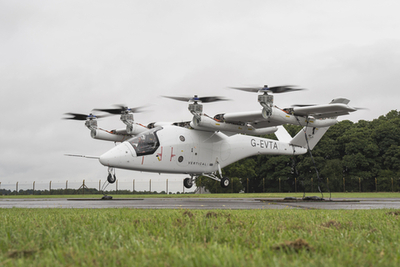New VX4 Prototype Completes First Tethered Piloted Flight
LONDON--(BUSINESS WIRE)--Vertical Aerospace (Vertical) [NYSE: EVTL], a global aerospace and technology company pioneering zero-emissions aviation, has seen its latest VX4 prototype perform its first tethered piloted flight as it begins the “wheels up” phase of testing.
This VX4 performed a piloted flight while loosely tethered to the ground, during which Vertical measured over 20,000 flight and system parameters to verify thrust, handling qualities and system performance.
The tethered piloted flight took place after the UK Civil Aviation Authority (CAA) had issued Vertical with a Permit to Fly for its VX4 prototype, having rigorously evaluated the engineering, design, test data and aircraft, effectively conducting a “mini certification” programme of the aircraft.
Vertical must submit documentation to the CAA to move through each flight phase, including extensive, detailed documentation covering every aspect from safety protocols and engineering specifications to operational procedures.
Following initial tethered flights, and once it has received permission from the CAA to expand the flight envelope, the VX4 will enter the next phase of testing which will start with further thrustborne flight testing. This will see the VX4 take-off and land vertically and conduct low speed flight manoeuvres with lift generated by the propellers.
Wingborne or conventional flight (CTOL) and the final critical test stage of piloted transition flight will follow, only once the CAA’s rigorous approval for this final phase of testing has been granted.
In advance of today’s first tethered flight, this week, the VX4 has successfully completed extensive ground testing, including powered propulsion testing of its advanced powertrain, which features proprietary battery packs capable of delivering 1.4 MW of peak power and which has been designed and built at the state-of-the-art Vertical Energy Centre.
Stuart Simpson, CEO of Vertical Aerospace, said:
“The first tethered flight of our new VX4 prototype is the result of 14 months of hard work – taking this advanced aircraft all the way from design, through to development and now into the air. This moment is testament to the skill and commitment of hundreds of talented colleagues in our business who have made our VX4 aircraft the best eVTOL out there.
“Everyone at Vertical Aerospace remains laser focused on achieving piloted transition as we continue to progress towards our ultimate goal of commercialisation and creating a new legacy for aviation.”
Notes to Editor
Piloted flight test programme explainer:
- Tethered: the VX4 will perform stabilised hover while loosely tethered to the ground.
- Thrustborne: the VX4 will take-off and land vertically and conduct low speed flight manoeuvres with lift generated by the propellers.
- Wingborne: the VX4 will take-off, fly and land like a conventional aircraft, with lift generated by the wing.
- Transition: The VX4 will transition between thrustborne and wingborne flight, and vice versa.
About Vertical Aerospace
Vertical Aerospace is a global aerospace and technology company pioneering electric aviation.
Vertical is creating a safer, cleaner and quieter way to travel. Vertical's VX4 is a piloted, four passenger, Electric Vertical Take-Off and Landing (eVTOL) aircraft, with zero operating emissions. Vertical combines partnering with leading aerospace companies, including GKN, Honeywell and Leonardo, with developing its own proprietary battery and propeller technology to develop the world’s most advanced and safest eVTOL.
Vertical has 1,500 pre-orders of the VX4 worth $6bn, with customers across four continents, including Virgin Atlantic, American Airlines, Japan Airlines, GOL and Bristow. Headquartered in Bristol, the epicentre of the UK’s aerospace industry, Vertical was founded in 2016 by Stephen Fitzpatrick, founder of the OVO Group, Europe’s largest independent energy retailer.
Vertical's experienced leadership team comes from top tier automotive and aerospace companies such as Rolls-Royce, Airbus, GM and Leonardo. Together they have previously certified and supported over 30 different civil and military aircraft and propulsion systems.



